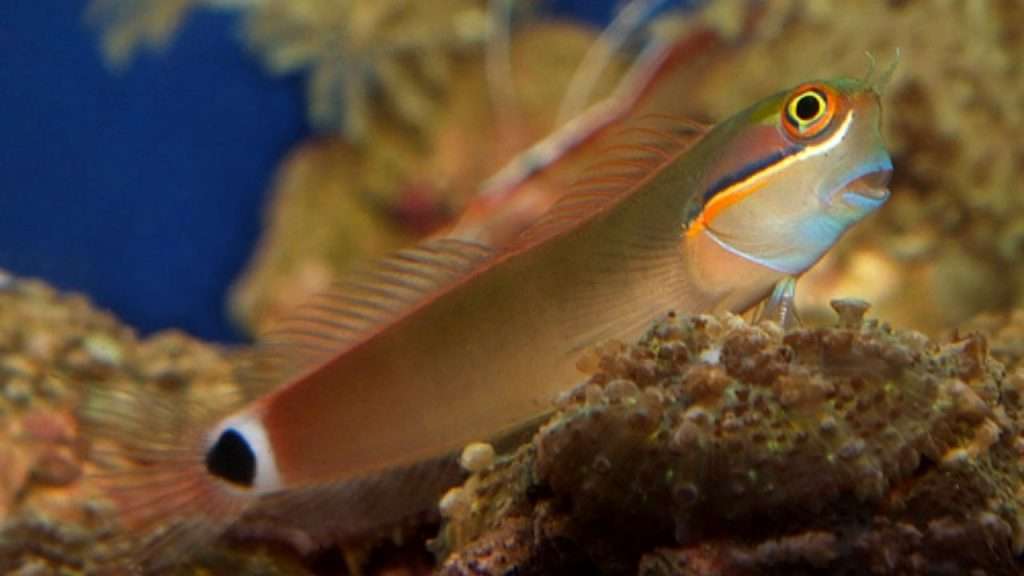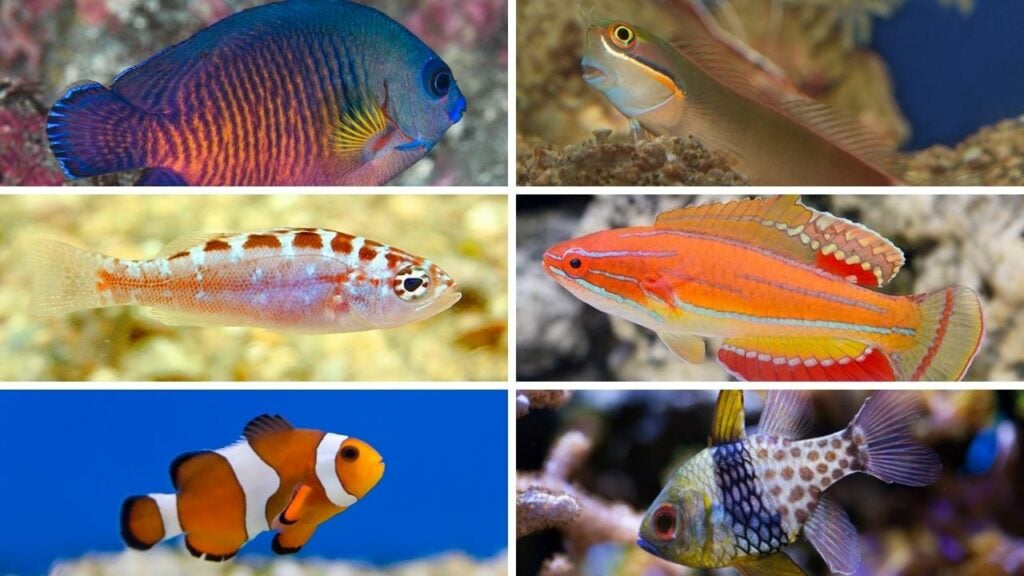
In compiling this list of 21 best saltwater fish for beginners, I have taken into consideration:
Care Level – All the fish below are easy to care for.
Hardiness – Fish that are more able to withstand water parameter changes.
Temperament – You don’t want the WWE Royal Rumble in your tank!!
Whenever possible I recommend you buy captive-bred fish rather than wild-caught. The price point will generally be higher, but your fish will be hardier and used to aquarium conditions already, so you will have a much higher survival rate.
More importantly, you’re supporting wild fish populations and the sustainability of our oceans. That’s a win-win all around!
- 1. Banggai Cardinalfish
- 2. Bicolor Blenny
- 3. Chalk Bass
- 4. Coral Beauty Angelfish
- 5. Diamond Goby
- 6. Firefish Goby
- 7. Flame Angelfish
- 8. Green Chromis
- 9. Lawnmower Blenny
- 10. Longnose Hawkfish
- 11. McCoskers Flasher Wrasse
- 12. Ocellaris Clownfish (False Percula / aka Nemo)
- 13. Pajama Cardinalfish
- 14. Purple Firefish Goby
- 15. Royal Gramma
- 16. Six Line Wrasse
- 17. Tailspot Blenny
- 18. Threadfin Butterflyfish
- 19. Yellow Clown Goby
- 20. Yellow Tang
- 21. Yellow Watchman Goby
- What Next?
- Final Thoughts On The Best Saltwater Fish For Beginners…
1. Banggai Cardinalfish

Name / Scientific Name: Banggai Cardinalfish / Pterapogon kauderni
Care Level: Easy
Temperament: Semi-aggressive
Maximum Size: 3 Inches
Minimum Tank Size: 30 Gallons
Reef Safe: Yes
Diet: Carnivore
Water Temperature: 72°-78° F
Salinity – sg: 1.020-1.025
Carbonate Hardness – dKH: 8-12
pH: 8.1-8.4
Silver body with black stripes, white spots, and striking long fins. Very hardy, generally peaceful, and reef safe, so a super easy fish to care for.
I recommend getting a mated pair and keeping them with other non-aggressive fish in a minimum tank size of 30 gallons.
They are slow swimmers that like to hover in one spot and are most active at night.
When spawning the male fish carry the eggs and shoot live babies out of their mouths, which is pretty cool to watch!
2. Bicolor Blenny
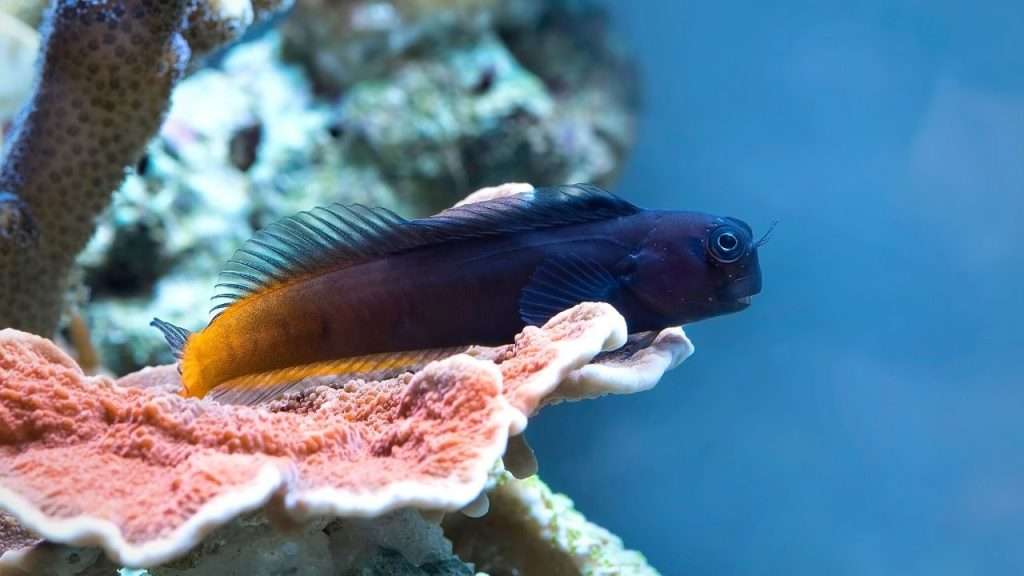
Name / Scientific Name: Bicolor Blenny / Ecsenius bicolor
Care Level: Easy
Temperament: Peaceful
Maximum Size: 4 Inches
Minimum Tank Size: 30 Gallons
Reef Safe: Yes
Diet: Herbivore
Water Temperature: 72°-78° F
Salinity – sg: 1.021-1.023
Carbonate Hardness – dKH: 8-12
pH: 8.1-8.4
Every tank needs a blenny to help control algae build-up. These guys need algae in their diet to stay healthy and will eat it all day long, they are particularly fond of hair algae. Once all the algae has been eaten you will need to supplement their diet with dried seaweed or something similar.
Hardy, active, reef safe, and very peaceful, but only keep 1 blenny per tank as they will become aggressive with other blennies. That being said, a buddy of mine has a 100 gallon tank with 2 of them and he’s said he has no problems with them fighting.
Provide them with rocks to perch on and crevices to hide in and you’ll have a very happy bicolor blenny.
3. Chalk Bass
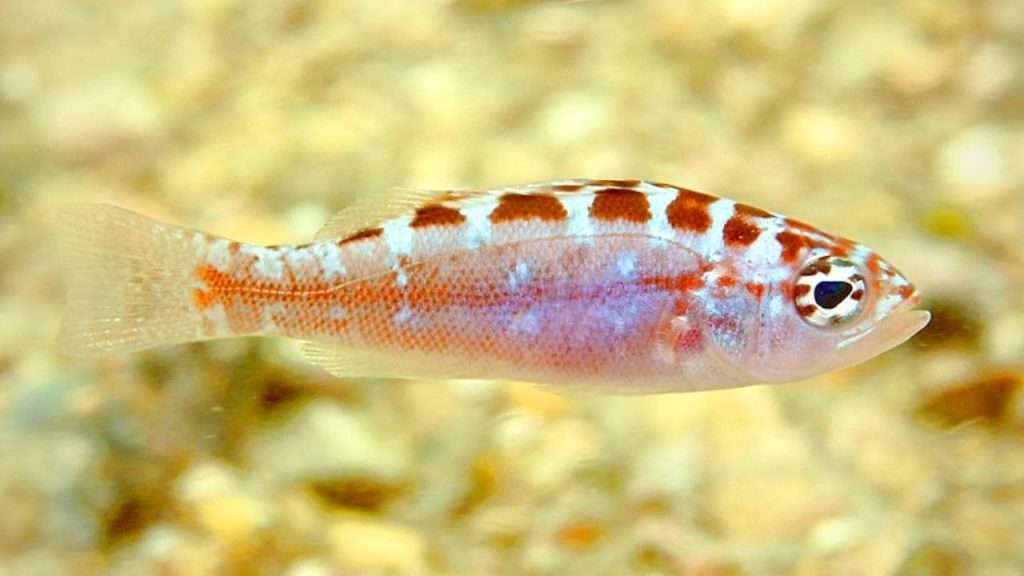
Name / Scientific Name: Chalk Bass / Serranus tortugarum
Care Level: Easy
Temperament: Semi-aggressive
Maximum Size: 3 Inches
Minimum Tank Size: 30 Gallons
Reef Safe: Yes
Diet: Carnivore
Water Temperature: 72°-78° F
Salinity – sg: 1.020-1.025
Carbonate Hardness – dKH: 8-12
pH: 8.1-8.4
A copper and blue striped hardy and very peaceful fish that is great for beginners. Growing to a maximum of 3″ these guys are ideal for a nano aquarium.
They’re a great option for a reef tank as they don’t nibble on corals. Keep a single fish in a nano aquarium or a small group can be kept in a larger tank (55+ gallons) if they are all added at the same time.
Full of character, my guys are always the first to swim to the side of the tank expecting to be fed!
4. Coral Beauty Angelfish

Name / Scientific Name: Coral Beauty Angelfish / Centropyge bispinosa
Care Level: Easy
Temperament: Semi-aggressive
Maximum Size: 4 Inches
Minimum Tank Size: 70 Gallons
Reef Safe: With Caution
Diet: Omnivore
Water Temperature: 72°-78° F
Salinity – sg: 1.020-1.025
Carbonate Hardness – dKH: 8-12
pH: 8.1-8.4
These little guys are my favorite dwarf angelfish. Their beautiful royal blue, orange and yellow colors will stand out in any aquarium.
Although small they need a fairly large tank (70+ gallons) as they are very active fish and love to eat algae all day long. Mine lives with other peaceful fish and I have never had any aggression issues. Only keep 1 dwarf angel per tank as they will be aggressive toward each other.
They are prone to nip at soft and stony corals, so may be better suited to a FOWLR aquarium. Mine hasn’t bothered my corals, so it’s up to you if you want to risk it.
Best added to an already established tank so there’s plenty of algae to nibble at.
5. Diamond Goby

Name / Scientific Name: Diamond Goby / Valencienna puellaris
Care Level: Easy
Temperament: Peaceful
Maximum Size: 6 Inches
Minimum Tank Size: 30 Gallons
Reef Safe: Yes
Diet: Carnivore
Water Temperature: 72°-78° F
Salinity – sg: 1.020-1.025
Carbonate Hardness – dKH: 8-12
pH: 8.1-8.4
Pearlescent white body with orange diamonds. Hardy, reef safe and peaceful towards other species of fish.
You should keep only 1 goby in the tank unless you get a mated pair and add them to a larger tank at the same time. Tank size should be at least 30 gallons and they will grow to around 6″.
This little fish is part of the tank’s clean-up crew. They need plenty of live sand to bury in and will sift it all day long to find food and keep it spotlessly clean for you. You need to make sure enough food is getting to the bottom of your tank or they will starve.
These guys are great little characters and are a great addition to any tank.
6. Firefish Goby
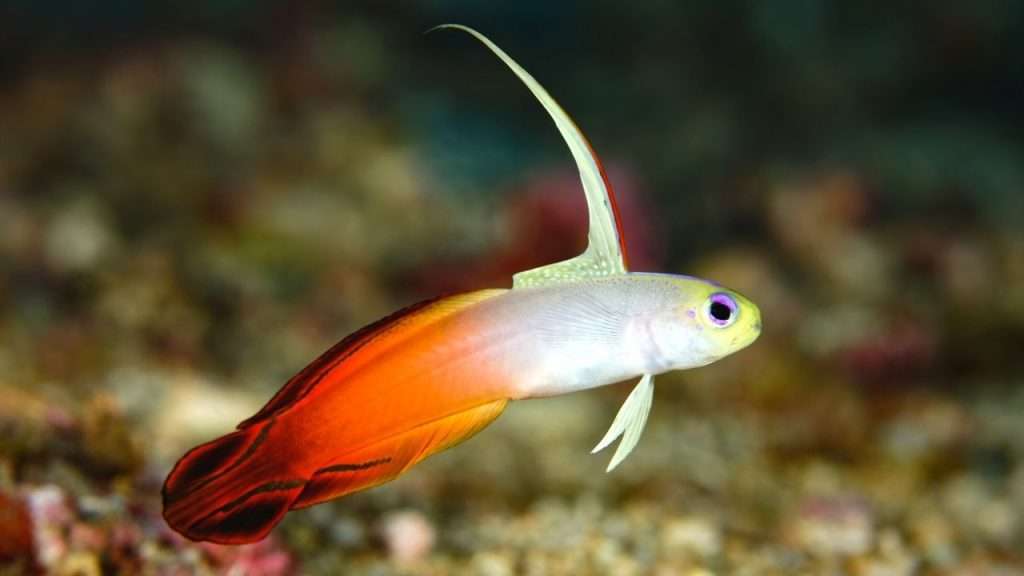
Name / Scientific Name: Firefish Goby / Nemateleotris magnifica
Care Level: Easy
Temperament: Peaceful
Maximum Size: 3 Inches
Minimum Tank Size: 20 Gallons
Reef Safe: Yes
Diet: Carnivore
Water Temperature: 72°-78° F
Salinity – sg: 1.020-1.025
Carbonate Hardness – dKH: 8-12
pH: 8.1-8.4
A striking-looking white, yellow, and red fish that looks like its tail is on fire. Peaceful with other species, reef safe, and easy to care for.
These guys are fun to watch as they dart around the tank super fast. Tank size should be at least 20 gallons, so a great fish for a nano tank.
You can keep them on their own or in groups. They can be timid at first, so need to have plenty of places to hide if they get startled. Don’t be alarmed if you don’t see them for a few days, they will reappear once settled in.
Although these are a goby, they won’t sift your sand and keep it clean as the diamond goby will.
7. Flame Angelfish

Name / Scientific Name: Flame Angelfish / Centropyge loricula
Care Level: Easy-moderate
Temperament: Semi-aggressive
Maximum Size: 4 Inches
Minimum Tank Size: 70 Gallons
Reef Safe: With Caution
Diet: Omnivore
Water Temperature: 72°-78° F
Salinity – sg: 1.020-1.025
Carbonate Hardness – dKH: 8-12
pH: 8.1-8.4
Their stunning flame orange with royal blue tips and black verticle stripes will add an awesome splash of color to your tank.
They love to nip at soft and stony corals, sessile invertebrates and clams, so best kept in a FOWLR aquarium. Like the coral beauty, your flame angelfish needs to be the only dwarf angel in the tank as they are territorial and will be aggressive towards each other.
They will get along with other peaceful fish, however, I recommend you add the flame angel to your tank last to avoid any territorial issues.
8. Green Chromis
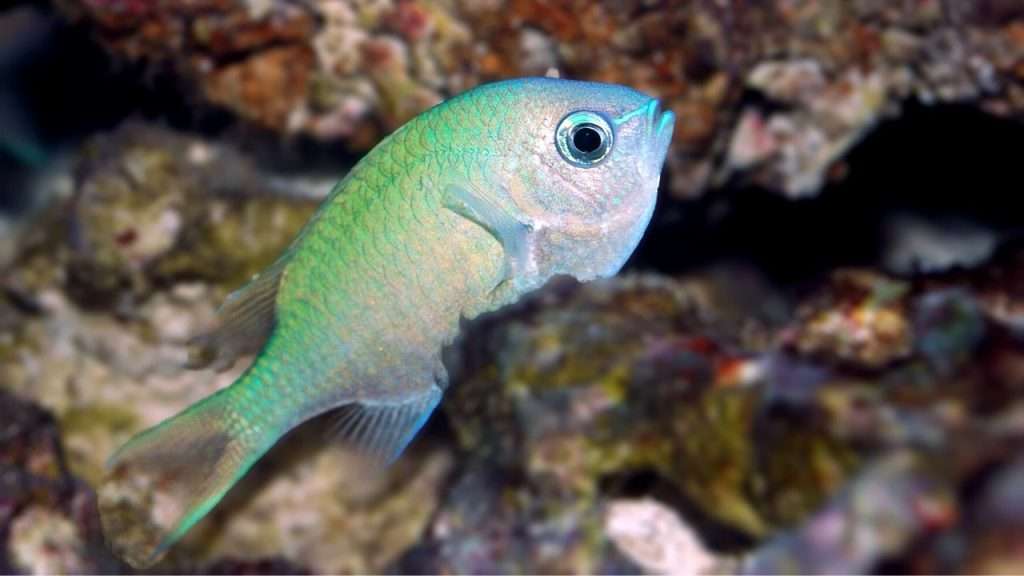
Name / Scientific Name: Green Chromis / Chromis viridis
Care Level: Easy
Temperament: Peaceful
Maximum Size: 4 Inches
Minimum Tank Size: 30 Gallons
Reef Safe: Yes
Diet: Omnivore
Water Temperature: 72°-78° F
Salinity – sg: 1.020-1.025
Carbonate Hardness – dKH: 8-12
pH: 8.1-8.4
An active fish with a beautiful shimmering pale green body. They are reef safe, hardy, and peaceful in a community tank.
You can keep them as a pair, but I recommend a minimum group size of 5 as they are naturally sociable, so like to be kept in groups.
Mine are always the first to the top of the tank when it’s feeding time and snatch at their food!! This can spook my other fish so to avoid this I spread the food out rather than putting it all in one spot.
9. Lawnmower Blenny
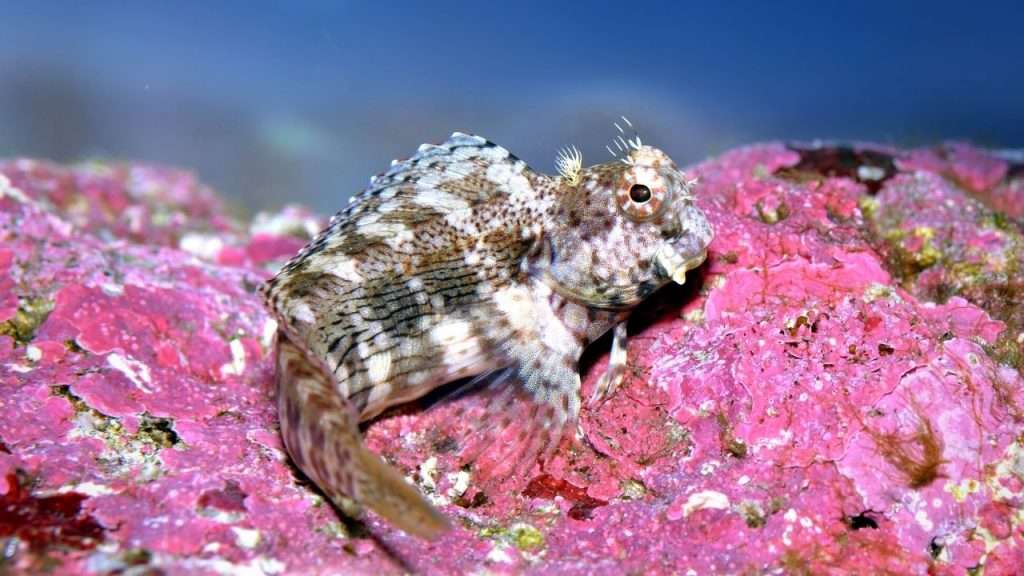
Name / Scientific Name: Lawnmower Blenny / Salarias fasciatus
Care Level: Easy-moderate
Temperament: Peaceful
Maximum Size: 5 Inches
Minimum Tank Size: 30 Gallons
Reef Safe: Yes
Diet: Herbivore
Water Temperature: 72°-78° F
Salinity – sg: 1.020-1.025
Carbonate Hardness – dKH: 8-12
pH: 8.1-8.4
Hardy, peaceful, and active fish that is great for beginners. He won’t win any beauty contests, some would say he has a face only a mother could love. What they lack in looks they sure make up for with personality!
This guy loves to eat, in particular hair algae, but will eat anything he finds.
Keep only 1 in the tank as it will fight with other blennies, but you can keep a mated pair in larger tanks of 100+ gallons.
The lawnmower blenny is best added to your tank once it’s well established and has plenty of algae growing for him to nibble at. Once all of the algae has gone you will need to supplement his diet with dried nori sheets, so he doesn’t starve.
10. Longnose Hawkfish
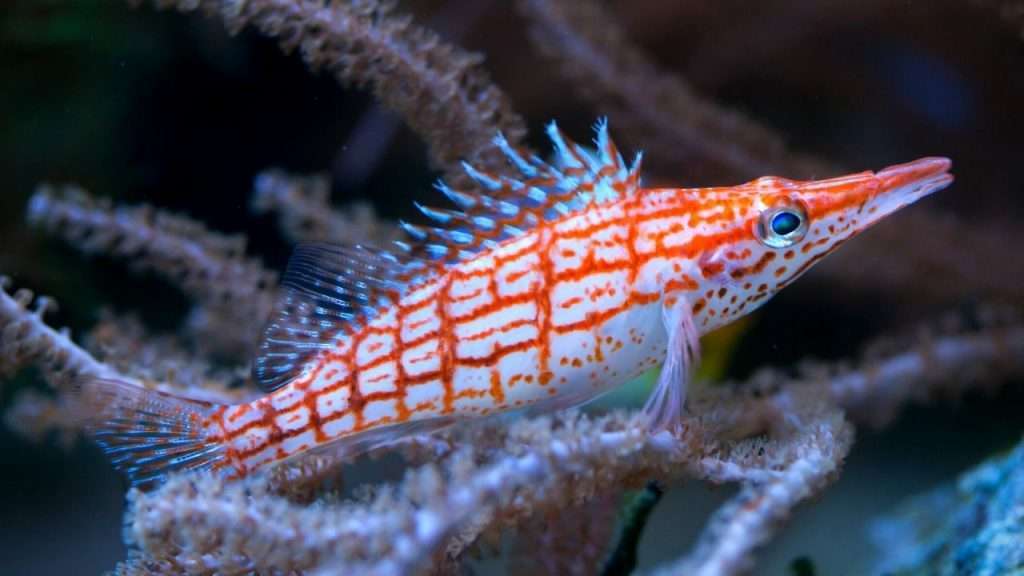
Name / Scientific Name: Longnose Hawkfish / Oxycirrhites typus
Care Level: Easy
Temperament: Semi-aggressive
Maximum Size: 5 Inches
Minimum Tank Size: 30 Gallons
Reef Safe: With Caution
Diet: Carnivore
Water Temperature: 72°-78° F
Salinity – sg: 1.020-1.025
Carbonate Hardness – dKH: 8-12
pH: 8.1-8.4
An unusual looking fish with a red and white plaid pattern that stands out from the crowd. Hardy, super easy to care for and fun to watch as they have great personalities.
If you’re going to put a longnose hawkfish in a community tank be aware that they will eat small fish, shrimp and crabs. If it will fit in their mouth they will eat it! So with that in mind choose tankmates wisely and make sure there is plenty of space for them all to live (100+ gallon tank). Add the longnose hawkfish to your community tank last to help avoid any aggression issues.
Because they don’t have a swim bladder, they need to have plenty of places to perch and hide like rocks, coral skeletons, or similar, so they can rest. They will become stressed if they don’t have anywhere to perch.
You will need a lid on your aquarium as they are known jumpers.
11. McCoskers Flasher Wrasse
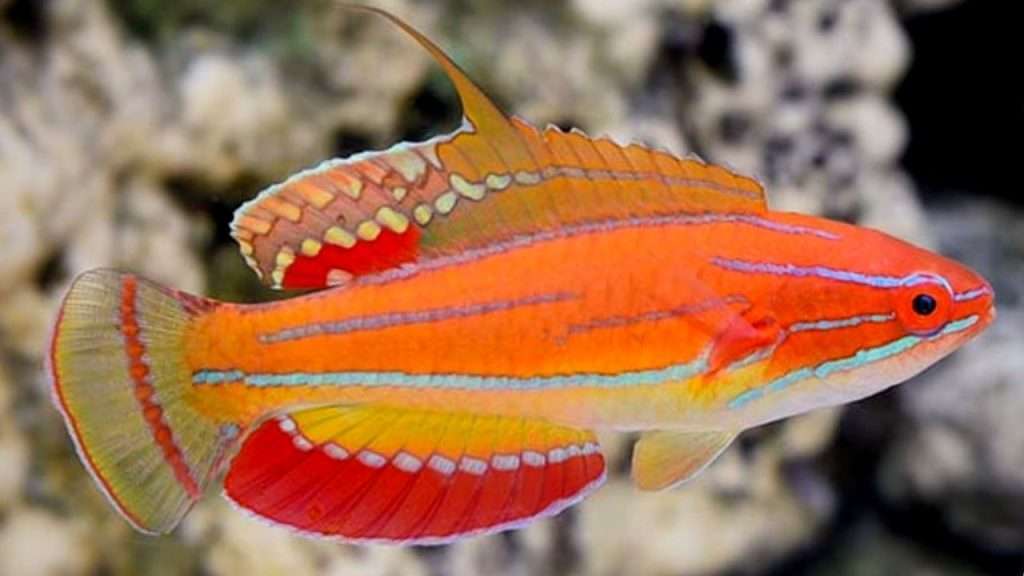
Name / Scientific Name: McCoskers Flasher Wrasse / Paracheilinus mccoskeri
Care Level: Easy-moderate
Temperament: Peaceful
Maximum Size: 3 Inches
Minimum Tank Size: 55 Gallons
Reef Safe: Yes
Diet: Carnivore
Water Temperature: 72°-78° F
Salinity – sg: 1.020-1.025
Carbonate Hardness – dKH: 8-12
pH: 8.1-8.4
A hardy and reef-safe fish with a peaceful temperament. When first introduced to the tank, they can be shy and may hide in the rocks, but they will soon settle into their new home and become very active.
Like other wrasses, they love to burrow in the tank bottom so provide them with plenty of fine sand as a substrate.
Vibrant orange with blue horizontal stripes with a white and yellow belly. Females are not as brightly colored as males, nor do they have large dorsal and anal fins. Juvenile fish are not as bright either, don’t worry if they look a bit bland in the fish store, their color develops as they grow.
Tank size should be at least 55 gallons and you should only keep 1 male McCoscker in your aquarium, he will live with a small group of 3-5 females. I recommend you add the male at the same time or after the females. A female-only group will live together, but the dominant female will become a male.
Ensure you have a tight-fitting lid on your tank as the McCoscker is a known escape artist.
12. Ocellaris Clownfish (False Percula / aka Nemo)

Name / Scientific Name: Ocellaris Clownfish / Amphiprion ocellaris
Care Level: Easy
Temperament: Peaceful
Maximum Size: 3 Inches
Minimum Tank Size: 20 Gallons
Reef Safe: Yes
Diet: Omnivore
Water Temperature: 72°-78° F
Salinity – sg: 1.023-1.025
Carbonate Hardness – dKH: 8-12
pH: 8.1-8.4
Without a doubt one of the most popular saltwater fish and most aquarist’s first fish.
Beautiful, hardy, peaceful, reef safe, and easy to care for, what’s not to like. They do tend to be a bit greedy and will eat most food – I think I used to be a clownfish in a past life!
There are many types of clownfish, but if you’d like a real-life Nemo (who doesn’t?) you need to look for the false percula ocellaris clownfish.
You can keep them on their own or as a pair. To keep them as a pair and avoid any aggression issues it’s best to buy 2 juveniles together. Both will be male when you buy them, but the more dominant fish will become female.
You’ll be able to tell them apart as the female will be the larger of the 2. You could also buy an already mated pair from your fish store.
Tank size should be at least 20 gallons, I see other people online saying they put them in 10 gallon tanks, but I feel that’s a bit on the small side, especially if you have a pair.
13. Pajama Cardinalfish

Name / Scientific Name: Pajama Cardinalfish / Sphaeramia nematoptera
Care Level: Easy
Temperament: Peaceful
Maximum Size: 3.5 Inches
Minimum Tank Size: 30 Gallons
Reef Safe: Yes
Diet: Carnivore
Water Temperature: 72°-78° F
Salinity – sg: 1.023-1.025
Carbonate Hardness – dKH: 8-12
pH: 8.1-8.4
Great beginner friendly fish, with unusual markings and big red eyes. They’re very peaceful, hardy, and get along well with other non-aggressive fish.
They are quite shy and slow swimming, preferring to hover in one spot.
These guys are happy on their own or you can keep them in groups of 3-5 (minimum of 30 gallon tank). Like the Banggai cardinalfish, they’re most active at night.
14. Purple Firefish Goby

Name / Scientific Name: Purple Firefish Goby / Nemateleotris decora
Care Level: Easy
Temperament: Peaceful
Maximum Size: 3.5 Inches
Minimum Tank Size: 20 Gallons
Reef Safe: Yes
Diet: Carnivore
Water Temperature: 72°-78° F
Salinity – sg: 1.020-1.025
Carbonate Hardness – dKH: 8-12
pH: 8.1-8.4
Vibrant purple and red fish that really stands out in your tank. Being hardy, reef safe and peaceful makes them super easy to care for.
Gets on well with most other species but will fight with other purple firefish, so best to keep only 1.
Superfast swimmers when they come out into the open, blink and you’ll miss them! They like caves to hide in, so make sure you provide some form of rock structure.
Yet another notorious jumper so keep a tight-fitting lid on your tank.
15. Royal Gramma

Name / Scientific Name: Royal Gramma / Gramma loreto
Care Level: Easy
Temperament: Peaceful
Maximum Size: 3 Inches
Minimum Tank Size: 30 Gallons
Reef Safe: Yes
Diet: Carnivore
Water Temperature: 72°-78° F
Salinity – sg: 1.020-1.025
Carbonate Hardness – dKH: 8-12
pH: 8.1-8.4
Striking-looking purple and yellow fish that will add some color to your tank. Hardy and peaceful with most other non-aggressive fish so an ideal fish for beginners.
Another bonus is that they won’t nibble away at your corals. These guys are timid, to begin with, and will most likely find a place to hide. However, they will soon settle in and get used to your other fish and you approaching the tank.
Only keep a single royal gramma (unless you have a larger tank of 55+ gallons) as they can be intolerant of each other.
Make sure you don’t confuse the royal gramma with the bicolor dottyback at your local fish store. They look similar but the bicolor dottyback has a more aggressive temperament and may terrorize your other fish.
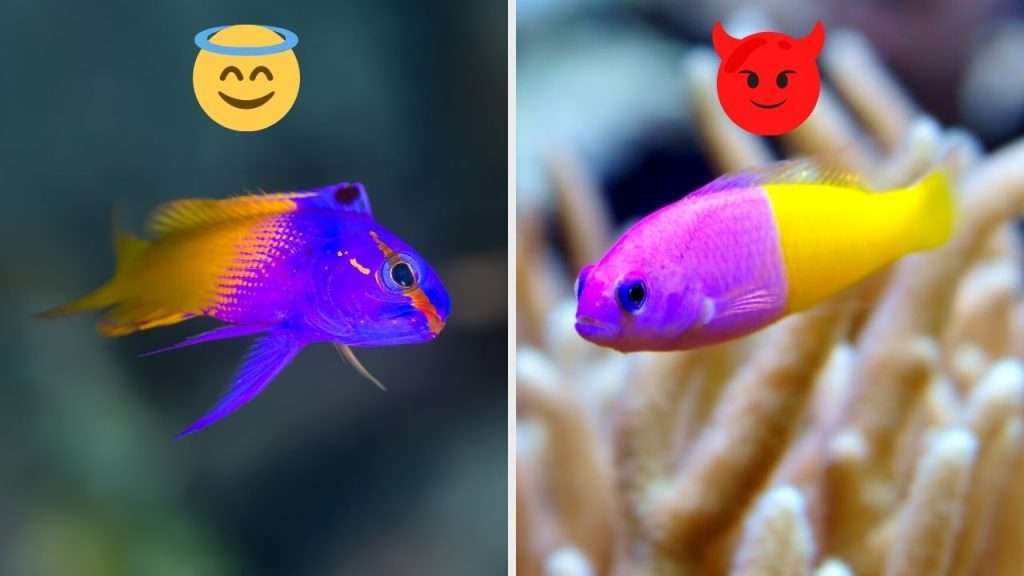
16. Six Line Wrasse
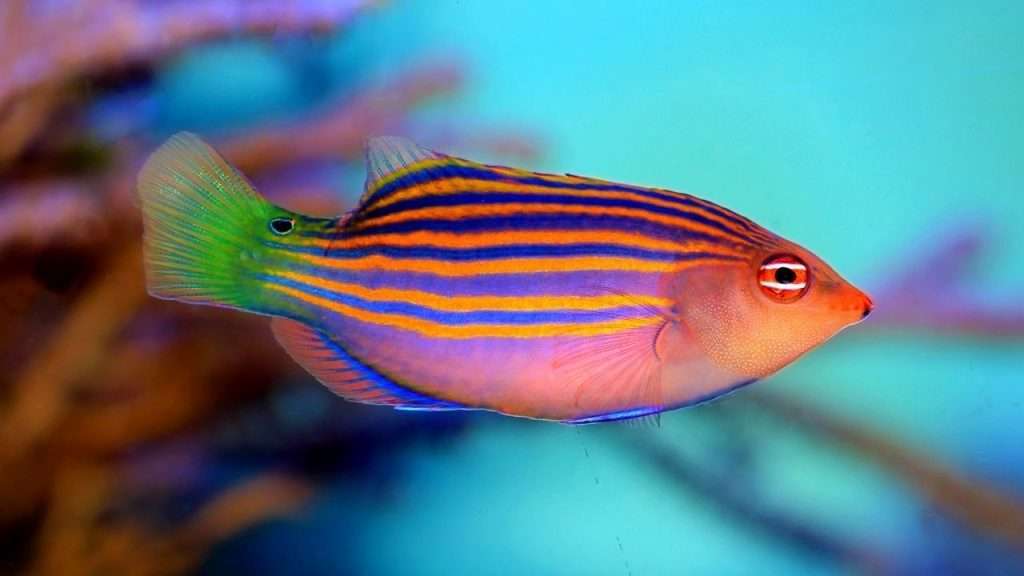
Name / Scientific Name: Six Line Wrasse / Pseudocheilinus hexataenia
Care Level: Easy-moderate
Temperament: Semi-aggressive
Maximum Size: 3 Inches
Minimum Tank Size: 55 Gallons
Reef Safe: Yes
Diet: Carnivore
Water Temperature: 72°-78° F
Salinity – sg: 1.020-1.025
Carbonate Hardness – dKH: 8-12
pH: 8.1-8.4
A very attractive blue and orange striped fish with a bright green tail. Mine loves to swim and weave between rocks and coral, checking out all the nooks and crannies searching for food.
Despite them being hardy and reef safe I was in 2 minds about whether to add this fish to the beginner’s list as they are a bit hit and miss with aggression, sometimes they are ok with other fish, other times they are jerks… or should that wrasse-holes!? 😂
They do a great job at helping keep your tank clean, they eat pests like bristle worms, flatworms, parasitic pyramis snails, and more. So for me, they’re a great choice and worth the risk.
If you do decide the six line wrasse is for you, don’t put them with shy and easily intimidated fish, or other wrasses. My six line was the last fish added to my tank and I make sure he’s well fed, so far I’ve had no territorial or aggression issues.
17. Tailspot Blenny
Name / Scientific Name: Tailspot Blenny / Ecsenius stigmatura
Care Level: Easy
Temperament: Peaceful
Maximum Size: 3 Inches
Minimum Tank Size: 10 Gallons
Reef Safe: Yes
Diet: Herbivore
Water Temperature: 72°-78° F
Salinity – sg: 1.020-1.025
Carbonate Hardness – dKH: 8-12
pH: 8.1-8.4
Super easy to care for small fish, suitable for a nano tank. Not as vibrantly colored as other blennies, but they have a really cute face and always look like they’re smiling.
They need to be kept with other peaceful fish as they can get bullied. They like plenty of rocks and crevices to hide in and will often be seen peeking out. Perfect fish for a nano tank as they only grow to 3″.
Like other blennies, only keep 1 per tank. They will nibble away on algae in your tank to help keep it under control.
Tailspots have super jumping powers so make sure you have a tight-fitting lid on your tank. Nobody wants to find a dried-up fish laying on their floor!
18. Threadfin Butterflyfish

Name / Scientific Name: Threadfin Butterflyfish / Chaetodon auriga
Care Level: Easy
Temperament: Peaceful
Maximum Size: 8 Inches
Minimum Tank Size: 100 Gallons
Reef Safe: No
Diet: Omnivore
Water Temperature: 72°-78° F
Salinity – sg: 1.021-1.023
Carbonate Hardness – dKH: 8-12
pH: 8.2-8.4
Lovely yellow and pearly white fish with black stripes that will stand out in your tank.
Butterflyfish can be difficult to care for, but the threadfin is one of the easiest. A peaceful, hardy fish that will get along with other fish species, but may be aggressive towards other butterflyfish, so only keep 1 per tank unless they’re added to a large aquarium at the same time.
You can keep them in a 55 gallon tank when they’re young, but they will outgrow this sized tank eventually and you’ll need to upgrade to a 100+ gallon tank.
They like plenty of hiding spots among the rocks as they can be shy. They are not suitable for a reef aquarium as they will eat soft and stony polyps and anemones and go after any ornamental shrimp in your tank.
19. Yellow Clown Goby
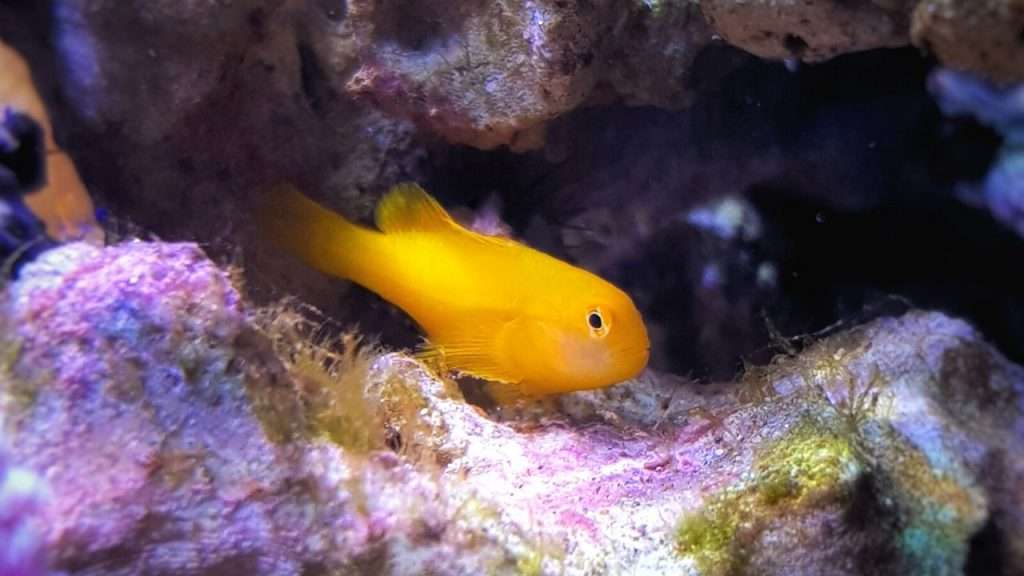
Name / Scientific Name: Yellow Clown Goby / Gobiodon okinawae
Care Level: Easy
Temperament: Peaceful
Maximum Size: 1.5 Inches
Minimum Tank Size: 10 Gallons
Reef Safe: Yes
Diet: Carnivore
Water Temperature: 72°-78° F
Salinity – sg: 1.020-1.025
Carbonate Hardness – dKH: 8-12
pH: 8.1-8.4
Lovely vibrant yellow, growing to a maximum of 1.5″ making them one of the best fish for a nano aquarium. Hardy and peaceful so super easy to care for, and will live happily with other non-aggressive fish.
Keep as a single specimen as they will fight with other yellow clown gobies unless you have a larger tank. A buddy of mine keeps 3 in his 75 gallon tank with no issues, it’s up to you if you want to risk it, but keep an eye out for fighting and separate them if so.
Despite their small size and initial shyness, they are full of personality. They like to spend their time perched on live rock or coral.
They are reef safe but will nip at SPS coral, so you may want to avoid this fish if your tank contains any.
20. Yellow Tang

Name / Scientific Name: Yellow Tang / Zebrasoma flavescens
Care Level: Easy
Temperament: Semi-aggressive
Maximum Size: 8 Inches
Minimum Tank Size: 100 Gallons
Reef Safe: Yes
Diet: Herbivore
Water Temperature: 72°-78° F
Salinity – sg: 1.020-1.025
Carbonate Hardness – dKH: 8-12
pH: 8.1-8.4
Beautiful bright yellow fish that will gracefully glide around your tank. Hardy, easy to care for, reef compatible, and will get along with most other fish in your aquarium. This makes them a great choice for beginners.
Growing up to 8″ and being active swimmers, they need a large tank with plenty of space to swim. They prefer a long tank (as opposed to a cube style) of at least 100 gallons.
Avoid housing with other tangs or surgeonfish, unless introduced at the same time. Yellow tangs can be territorial so if you’re adding them to a community tank they need to be one of the last fish you add. This will allow the other fish to claim their spot and keep your tang from taking over the tank.
21. Yellow Watchman Goby

Name / Scientific Name: Yellow Watchman Goby / Cryptocentrus cinctus
Care Level: Easy
Temperament: Peaceful
Maximum Size: 4 Inches
Minimum Tank Size: 30 Gallons
Reef Safe: Yes
Diet: Carnivore
Water Temperature: 72°-78° F
Salinity – sg: 1.020-1.025
Carbonate Hardness – dKH: 8-12
pH: 8.1-8.4
Yellow with bright blue spots, known for their grumpy expression and great personalities! Hardy, reef safe and gets along with other peaceful fish.
They can form symbiotic relationships with pistol shrimps. The shrimp shares their cave in exchange for the goby keeping a watch over the shrimp and alerting it to danger.
Make sure you have plenty of sand and live rock for them to burrow underneath. You’ll often see them peeking their head out guarding their little cave.
The watchman goby will sift the sand in the area where it lives, but won’t clean all your sand as the diamond goby will.
Tank size should be at least 30 gallons and they grow to a maximum size of 4″. You can keep them with other peaceful fish, apart from other gobies, as they’re intolerant of their own kind.
What Next?
Before choosing your favorite fish, you need to consider what type of aquarium do you want to keep?
There are 3 main types of saltwater aquarium:
1: Fish Only
It doesn’t get much simpler than a FO aquarium. You just have fish, no live rock or corals, and generally sparsely decorated. The fish are the stars of the show.
2: FOWLR
FOWLR is a term you’ll hear often in fish keeping. It stands for Fish Only With Live Rock. Live rock acts as a natural filter and is home to millions of beneficial nitrifying bacteria that will keep your aquarium healthy and help maintain stable water parameters.
3: Reef
A reef aquarium contains live rock, reef-safe fish, corals, and other marine invertebrates. Reef aquariums look amazing, but corals can be tricky for beginners as they generally require very specific water and lighting conditions.
I recommend a FOWLR aquarium for beginners, although live rock can be expensive, it will help keep your water parameters more stable. You can also choose from a wider variety of fish, as a lot of fish like to hide amongst or perch on the rock.
Once you’ve decided what type of aquarium you want to keep:
- Make a list of the fish you like, based on your chosen aquarium type and tank size (gallons).
- Check that your chosen fish are compatible with each other if you are having a community tank.
- Make sure your tank is fully cycled, before adding your fish.
- Add the fish to your tank slowly, don’t add all of them at once, patience is the name of the game!
Start with timid fish first, then add ones that feed on algae, and finally add any territorial fish. - Don’t overstock your tank, as tempting as it is to have lots of fish, this makes it difficult to keep your water parameters stable. Less is more!
- I recommend having a tight-fitting lid on all aquariums, it’s no fun coming down in the morning to find your little buddy dried up on the floor.
Final Thoughts On The Best Saltwater Fish For Beginners…
There you have it, my top picks for the best saltwater fish for beginners, now it’s over to you to pick your favorites.
See my best saltwater tanks for beginners post, if you haven’t already got a tank.
Check out my equipment section for in-depth reviews and my aquarium health section for guides and tips on how to keep your aquarium in tip-top shape.

